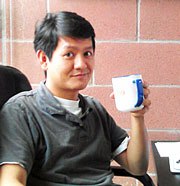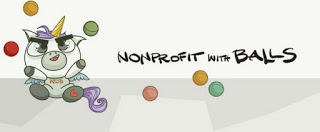Hello all. I like to kick off July with a review and refresh of my “scanning list” to ensure I’m fueling my foresight with diverse voices and perspectives. This is a plug for you to do the same. In the coming month I will make a few recommendations for sources that may not yet be on your radar. Please reciprocate with recommendations of your own in the comments section below.
First up, Nonprofit with Balls—a sly, humorous and dead-on look at the nonprofit world from Vu Le, director of Rainier Valley Corps in Seattle. I’m not going to explain the name of this blog (you can see what Vu himself has to say about that), but I will point to a few of my favorite recent posts:
 |
| Vu Le |
So, you don’t think you directly benefit from nonprofits—in which Vu goes on an awesome rant making the case that everyone benefits from the work of nonprofits. To quote one of his best bits: “Just because you can’t hold or see something does not mean you do not benefit from it. All of us benefit more from nonprofits’ work than we’ll ever know. If you feel safe walking down the street, it’s probably because there are nonprofits working on neighborhood safety and providing services to those who need help. If you appreciate all the free art and music all around you, it’s probably because there are nonprofits supporting kick-ass artists and musicians in the community.” What provoked the rant? His observation that “this philosophy of “we don’t benefit directly from the work of nonprofits” seems to be prevalent in our society, and it’s been leading to no-good, very-bad things like restricted funding and fear of overhead and unwillingness to pay for nonprofit professionals’ salaries.” I agree, and add that this attitude seems to be spreading. We can’t settle for documenting direct impact (which is hard enough). Nonprofits as a sector, including museums, need to show we make the world a better place even for people who never visit museums.
As a third fav, I’ll tag Are you or your org guilty of Trickle-Down Community Engagement? Vu defines TDCE as “when we [nonprofits] bypass the people who are most affected by issues, engage and fund larger organizations to tackle these issues, and hope that miraculously the people most affected will help out in the effort, usually for free.” He does a great job deconstructing the causes and the effects of TDCE, and offers some advice to funders, donors, mainstream (e.g., big) nonprofits organizations and those led by marginalized communities. The advice that resonates most strongly for me is directed at nonprofits, whether mainstream or marginalized: if you are mainstream, offer, and if you are marginalized, hold out for, strategic, equitable partnerships that help smaller organizations build capacity to do their own good work.

Katherine McNamee, AAM’s HR director, heard Vu speak at the Nonprofit HR Talent Summit in April, and reports that he rocked the podium, so if you are a conference organizer, maybe keep that in mind as well. And then let me know he’s on your program, so I can come listen as well.
Elizabeth Merritt












